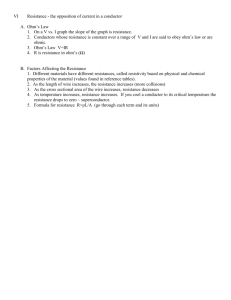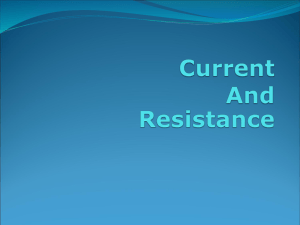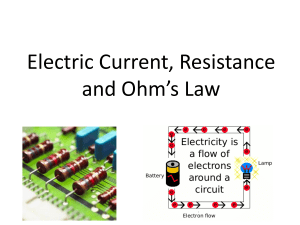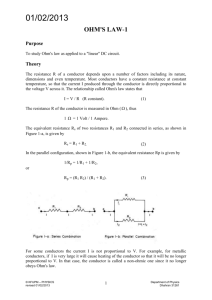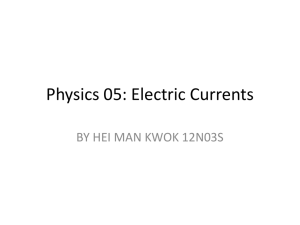ELECTRIC CURRENT: OHMIC AND NON
advertisement
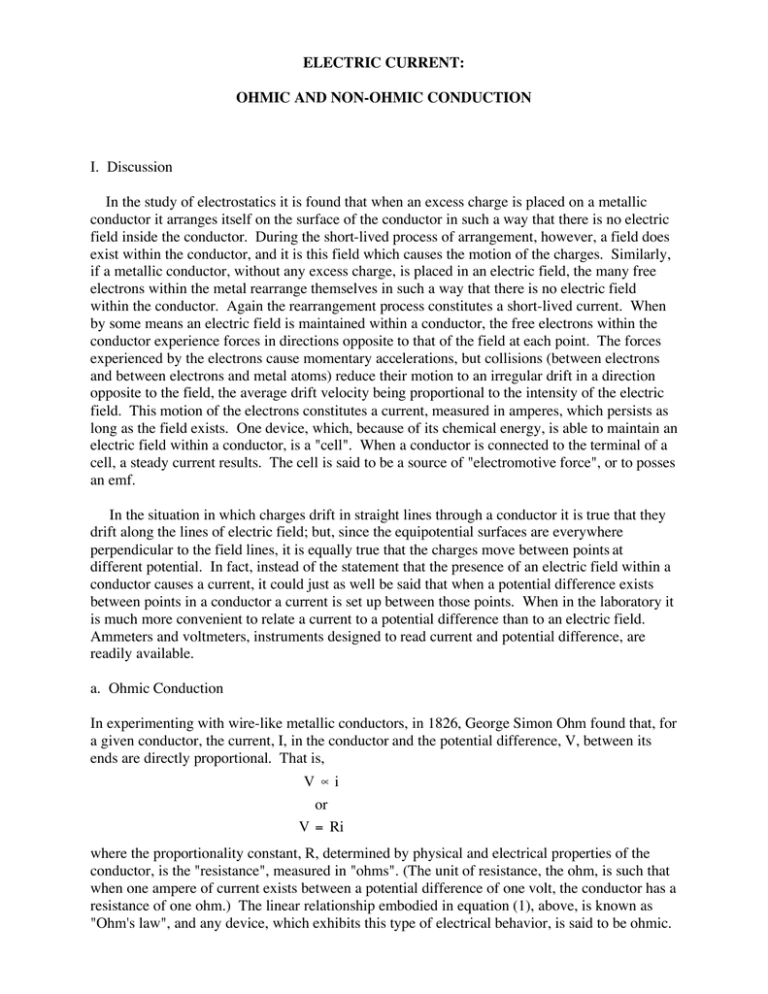
ELECTRIC CURRENT: OHMIC AND NON-OHMIC CONDUCTION I. Discussion In the study of electrostatics it is found that when an excess charge is placed on a metallic conductor it arranges itself on the surface of the conductor in such a way that there is no electric field inside the conductor. During the short-lived process of arrangement, however, a field does exist within the conductor, and it is this field which causes the motion of the charges. Similarly, if a metallic conductor, without any excess charge, is placed in an electric field, the many free electrons within the metal rearrange themselves in such a way that there is no electric field within the conductor. Again the rearrangement process constitutes a short-lived current. When by some means an electric field is maintained within a conductor, the free electrons within the conductor experience forces in directions opposite to that of the field at each point. The forces experienced by the electrons cause momentary accelerations, but collisions (between electrons and between electrons and metal atoms) reduce their motion to an irregular drift in a direction opposite to the field, the average drift velocity being proportional to the intensity of the electric field. This motion of the electrons constitutes a current, measured in amperes, which persists as long as the field exists. One device, which, because of its chemical energy, is able to maintain an electric field within a conductor, is a "cell". When a conductor is connected to the terminal of a cell, a steady current results. The cell is said to be a source of "electromotive force", or to posses an emf. In the situation in which charges drift in straight lines through a conductor it is true that they drift along the lines of electric field; but, since the equipotential surfaces are everywhere perpendicular to the field lines, it is equally true that the charges move between points at different potential. In fact, instead of the statement that the presence of an electric field within a conductor causes a current, it could just as well be said that when a potential difference exists between points in a conductor a current is set up between those points. When in the laboratory it is much more convenient to relate a current to a potential difference than to an electric field. Ammeters and voltmeters, instruments designed to read current and potential difference, are readily available. a. Ohmic Conduction In experimenting with wire-like metallic conductors, in 1826, George Simon Ohm found that, for a given conductor, the current, I, in the conductor and the potential difference, V, between its ends are directly proportional. That is, V%i or V = Ri where the proportionality constant, R, determined by physical and electrical properties of the conductor, is the "resistance", measured in "ohms". (The unit of resistance, the ohm, is such that when one ampere of current exists between a potential difference of one volt, the conductor has a resistance of one ohm.) The linear relationship embodied in equation (1), above, is known as "Ohm's law", and any device, which exhibits this type of electrical behavior, is said to be ohmic. When the potential difference across an ohmic device is reversed in polarity, the current reverses direction, but the proportionality constant, R, in Ohm's law of eqn. (1), above, remains constant. This is shown in Fig. 1 (a), below. V V (volts) (volts) i (amps) i (amps) Fig.1 (a) (b) b. Non-Ohmic Conduction A conductor is a material, which at room temperature contains a large number of free charges (electrons) per unit volume, while an insulator is a material, which under the same conditions contains comparatively few free charges. The relative abundance or scarcity of free charges affects strongly the electrical properties of a material. Between the two extremes, conductors and insulators, lies a group of materials called "semi-conductors", whose electrical properties may be altered by causing the material to undergo rather slight physical or chemical changes. At a certain type of junction, for example, between two types of semi-conductors it is found that charge flows more freely through the junction in one direction than in the other. Moreover, the current through the junction and potential difference across it are not linearly related. Thus the junction device called a diode will not, in general, obey Ohm's law, and is said, therefore, to be non-ohmic The relationship between current and potential difference for a typical non-ohmic diode is shown in Fig. 1 (b), above. II. Collection of Data In this laboratory exercise, ohmic and non-ohmic behavior will be investigated by determining the relationship between the current and the potential difference for a resistor and a diode, respectively. A resistor is made up solely of conducting materials, while a diode contains a junction of semi-conductor materials. The circuit to be used is shown schematically in Fig. 2, below, where the device between the A points x and y is either x the resistor or the DC diode. Supply V y Fig. 2 The voltage source available for this experiment is most likely the power supply built into the end of the lab table. The DC output is obtained from the red and black jacks and the voltage varies in the range of about 0- 20 volts when the knob is turned. The charges move from the DC supply through the ammeter, through the resistor (or diode) and back to the supply. The ammeter and voltmeter are two DMMs (Digital Multimeters) used in the appropriate modes. (Remember: Ammeters (A) are connected in series with the device whose current is to be measured, while voltmeters (V) are connected in parallel with the device whose potential difference to be measured.) a. Ohmic Conduction With the resistor in the circuit, vary the potential difference of the DC supply (in the range of 0 to 10 or 20 volts) to obtain about 10 data pairs of the voltage and the current. Then, reverse the ends of the resistor at points x and y so the current direction is reversed, and obtain data pairs of voltage and current like before. For the reverse case, you will consider the voltage and current to be negative. (Please organize your recorded data in some orderly table.) b. Non-ohmic Conduction With the diode in the circuit instead of the resistor, again obtain about 10 data pairs of voltage and current. Use only the "forward" direction with the diode. The "forward" direction is the only orientation that will give you measurable currents. CAUTION! Limit the current in the diode to a maximum of 200 ma. Turn the DC supply knob slowly and carefully since this current limit will be reached before the voltage is even 1 volt! As you increase the voltage, the current really increases rapidly and before you know it you will have blown the fuse in the ammeter. III. Graphs a . Ohmic Conduction Plot V vs I for the resistor. All of your data (both directions) should be on a single graph where the first direction shows positive voltages and currents and the reversed direction shows negative voltages and currents. Use the Graphical Analysis program on the computers. The slope is the resistance, and the uncertainty of the slope is the uncertainty of the resistance. If your want the slope to have units of ohms you must plot volts vs amperes, instead of the milliamperes you probably recorded from the ammeter. b. Non-ohmic Conduction Plot V vs I for the diode. Draw the curved line connecting the data points. IV. Results and Conclusions Resistor: Does the graph support the claim that the resistor is an ohmic device? Report your results (in ohms) for the quantities defined below. Calculate the percent difference between R and the other two measures. R=The resistance value found from the slope of the V vs. I graph. Rm=The resistance value found by measuring with the ohmmeter. Rc=The resistance value found from the color code. Diode: Does the graph support the claim that the diode is an ohmic device? Using your data for the forward biased diode, calculate the resistance using the voltage and current reading with(a) the smallest (non zero) current. (b) the largest current. Question: If an ammeter in this experiment reads .160 amp., and is uncertain by ±.005 amp, and if the voltmeter reads 1.22 v, and is uncertain by ±.02 v, what is the resistance and its uncertainty? Written by J. Robert O'Donnell Modified by Barry L. Hurst
